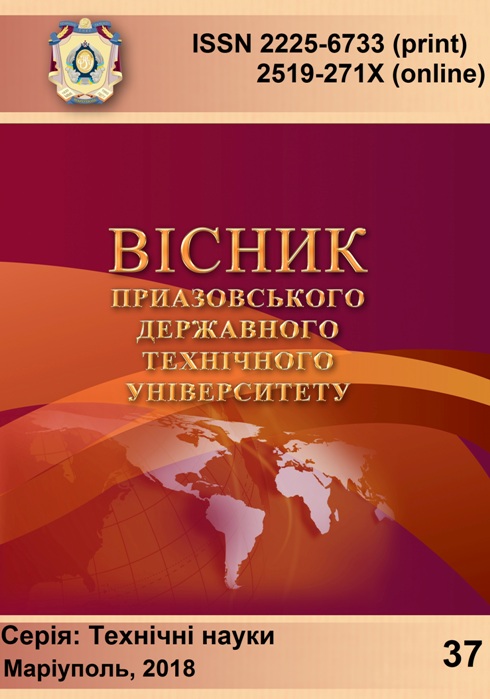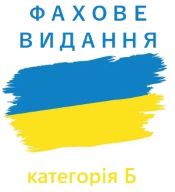Структура та механічні властивості високоміцної сталі після Q-n-P-інтегрованої термічної обробки
DOI:
https://doi.org/10.31498/2225-6733.37.2018.160232Ключові слова:
Q-n-P обробка, аустеніт, мартенсит, міцність, пластичність, ударна в’язкістьАнотація
В статті описано зміну мікроструктури та механічних властивостей економнолегованої високоміцної сталі 55С3Г2ХФМБА після різних Q-n-P (Quenching and partitioning)-інтегрованих режимів термічної обробки. Показано, що застосуванням технологічних схем з подовженою витримкою при 160°С, з попередньою бейнітизацією або з термоциклюванням можливо суттєво підвищити комплекс механічних властивостей сталі 55С3Г2ХФМБА в порівнянні із загартуванням та відпуском при 200-300°С. Встановлено, що формування структурно-вільного фериту не забезпечує підвищення пластичності сталі у порівнянні з іншими схемами обробки. Найбільш високі результати досягнуті термічною обробкою за схемою ТЦО+Q-n-P з трьома циклами 160«250°С, яка забезпечує сталі 55С3Г2ХФМБА високоміцний стан (sв = 1941-2116 МПа) при d = 10-16%, що покращує комплекс властивостей сталі у порівнянні з загартуванням і відпуском у 5 разів (PSE – 31,5 ГПа×% і 6,3 ГПа×%, відповідно). Підвищений (до 74-79 Дж/см2) рівень ударної в’язкості сталі 55С3Г2ХФМБА у стані ТЦО+Q-n-P та В-Q-n-P обробок дозволяє використовувати її в умовах високих циклічних і ударних навантажень. Крім того, згідно з результатами, показаними в статті, за своїми властивостями сталь 55С3Г2ХФМБА в стані Q-n-P-інтегрованої обробки вкладається у вимоги, що пред’являються для високоміцних сталей 3-го покоління. Високоміцний стан досягнуто за рахунок формування багатофазної структури, що складається з відпущеного мартенситу, нижнього бейніту та підвищеної кількості збагаченого вуглецем залишкового аустеніту. Отримані результати демонструють перспективність цієї технології в області підвищення комплексу механічних властивостей економнолегованих машинобудівних та інструментальних сталейПосилання
Список использованных источников (ГОСТ):
Carbon partitioning into austenite after martensite transformation / J.G. Speer [et al.] // Acta Materialia. – 2003. – № 51 (9). – Pp. 2611-2622. – Mode of access: DOI: 10.1016/S1359-6454(03)00059-4.
Partitioning of carbon from supersaturated plates of ferrite, with application to steel processing and fundamentals of the bainite transformation / J.G. Speer [et al.] // Current opinion in solid state and materials science. – 2004. – № 8 (3). – Pp. 219-237. – Mode of access: DOI: 10.1016/j.cossms.2004.09.003.
Quenching and partitioning martensite – A novel steel heat treatment / D.V. Edmonds [et al.] // Materials Science and Engineering: A. – 2006. – № 438. – Pp. 25-34. – Mode of access: DOI: 10.1016/j.msea.2006.02.133.
Tensile behaviour of a nanocrystalline bainitic steel containing 3 wt% silicon / C. Garcia-Mateo [et al.] // Materials Science and Engineering: A. – 2012. – № 549. – Pp. 185-192. – Mode of access: DOI: 10.1016/j.msea.2012.04.031.
A novel Mo and Nb microalloyed medium Mn TRIP steel with maximal ultimate strength and moderate ductility / M. Cai [et al.] // Metallurgical and Materials Transactions A. – 2014. – № 45 (12). – Pp. 5624-5634. – Mode of access: DOI: 10.1007/s11661-014-2504-x.
Microstructural evolution and tensile properties of 70 GPa•% grade strong and ductile hot-rolled 6Mn steel treated by intercritical annealing / J. Li [et al.] // Materials Science and Engineering: A. – 2019. – № 745. – Pp. 212-220. – Mode of access: DOI: 10.1016/j.msea.2018.12.110.
Socrate S. Mechanics of microvoid nucleation and growth in high-strength metastable austenitic steels: thesis (Ph. D.) / S. Socrate. – Massachusetts institute of technology, Dept. of mechanical engineering, 1995. – 242 p.
Influence of alloying elements on the microstructure evolution and mechanical properties in quenched and partitioned steels / N. Maheswari [et al.] // Materials Science & Engineering A. – 2014. – № 600. – Pp. 12-20. – Mode of access: DOI: 10.1016/j.msea.2014.01.066.
Ефременко В.Г. Технологические схемы термической обработки низколегированной стали на основе Q&P-принципа / В.Г. Ефременко, В.И. Зурнаджи, В.Г. Гаврилова // Научный вестник Донбасской государственной машиностроительной академии. – 2017. – № 1 (22E). – C. 15-23.
Schmitt J.H. New developments of advanced high-strength steels for automotive applications / J.H. Schmitt, T. Iung // Comptes Rendus Physique. – 2018. – № 19 (8). – Pp. 641-656. – Mode of access: DOI: 10.1016/j.crhy.2018.11.004.
Effects of stress relief tempering on microstructure and tensile/impact behavior of quenched and partitioned commercial spring steel / V.I. Zurnadzhy [et al.] // Materials Science and Engineering: A. – 2019. – № 745 – Pp. 307-318. – Mode of access: DOI: 10.1016/j.msea.2018.12.106.
Бурова Д.В. Підвищення властивостей низьколегованих конструкційних сталей з різним вмістом вуглецю термічною обробкою з нагрівом в міжкритичний інтервал температур : дис. … канд. техн. наук : 05.16.01 / Бурова Дар’я Володимирівна. – Маріуполь, 2016. – 178 с.
References:
Speer J.G., Matlock D.K., De Cooman B.C., Schroth J.G. Carbon partitioning into austenite after martensite transformation. Acta Materialia, 2003, no. 51 (9), pp. 2611-2622. doi: 10.1016/S1359-6454(03)00059-4.
Speer J.G., Edmonds D.V., Rizzo F.C., Matlock D.K. Partitioning of carbon from supersaturated plates of ferrite, with application to steel processing and fundamentals of the bainite transformation. Solid State and Materials Science, 2004, no. 8, pp. 219-237. doi: 10.1016/j.cossms.2004.09.003.
Edmonds D.V., He K., Rizzo K., De Cooman B.C., Matlock D.K., Speer J.G. Quenching and partitioning martensite – A novel steel heat treatment. Materials Science and Engineering: A, 2006, no. 438, pp. 25-34. doi: 10.1016/j.msea.2006.02.133.
Garcia-Mateo C., Caballero F.G., Sourmail T., Kuntz M., Cornide J., Smanio V., Elvirad R. Tensile behaviour of a nanocrystalline bainitic steel containing 3 wt% silicon. Materials Science and Engineering: A, 2012, no. 549, pp. 185-192. doi: 10.1016/j.msea.2012.04.031.
Cai M., Li Z., Chao Q., Hodgson P.D. A novel Mo and Nb microalloyed medium Mn TRIP steel with maximal ultimate strength and moderate ductility. Metallurgical and Materials Transactions A, 2014, no. 45 (12), pp. 5624-5634. doi: 10.1007/s11661-014-2504-x.
Li J., Song R., Li X., Zhou N., Song R. Microstructural evolution and tensile properties of 70 GPa•% grade strong and ductile hot-rolled 6Mn steel treated by intercritical annealing. Materials Science and Engineering: A, 2019, no. 745, pp. 212-220. doi: 10.1016/j.msea.2018.12.110.
Socrate S. Mechanics of microvoid nucleation and growth in high-strength metastable austenitic steels. Thesis (Ph. D.). Massachusetts institute of technology, 1995. 242 p.
Maheswari N., Chowdhury S.G., Hari Kumar K.C., Sankaran S. Influence of alloying elements on the microstructure evolution and mechanical properties in quenched and partitioned steels. Materials Science & Engineering: A, 2014, no. 600, pp. 12-20. doi: 10.1016/j.msea.2014.01.066.
Efremenko V.H., Zurnadzhy V.I., Gavrilova V.H. Tehnologicheskie shemy termicheskoj obrabotki nizkolegirovannoj stali na osnove Q&P principa [Technological schemes of low-alloy steel’s heat treatment based on Q&P principle]. Nauchnyi vestnik Donbasskoi gosudarstvennoi mashinostroitel’noi akademii – Scientific Herald of the Donbass State Engineering Academy, 2017, no. 1, pp. 15-23. (Rus.)
Schmitt J.H., Iung T. New developments of advanced high-strength steels for automotive applications. Comptes Rendus Physique, 2018, no. 19 (8), pp. 641-656. doi: 10.1016/j.crhy.2018.11.004.
Zurnadzhy V.I., Efremenko V.G., Wu K.M., Azarkhov A.Yu., Chabak Yu.G., Greshta V.L., Isayev O.B., Pomazkova M.V. Effects of stress relief tempering on microstructure and ten-sile/impact behavior of quenched and partitioned commercial spring steel. Materials Science and Engineering: A, 2019, no. 745, pp. 307-318. doi: 10.1016/j.msea.2018.12.106.
Burova D.V. Pidvyshhennja vlastyvostjej nyz’koljegovanyh konstrukcijnyh staljej z riznym vmistom vugljecju tjermichnoju obrobkoju z nagrivom v mizhkrytychnyj intjerval tjempjeratur. Diss. kand. techn. nauk [Improving the properties of low-alloy structural steels with different carbon content using heat treatment with heating in the intercritical temperature range. Cand. tech. sci. diss.]. Mariupol, 2016. 178 p. (Ukr.)
##submission.downloads##
Опубліковано
Як цитувати
Номер
Розділ
Ліцензія
Журнал "Вісник Приазовського державного технічного університету. Серія: Технічні науки" видається під ліцензією СС-BY (Ліцензія «Із зазначенням авторства»).
Дана ліцензія дозволяє поширювати, редагувати, поправляти і брати твір за основу для похідних навіть на комерційній основі із зазначенням авторства. Це найзручніша з усіх пропонованих ліцензій. Рекомендується для максимального поширення і використання неліцензійних матеріалів.
Автори, які публікуються в цьому журналі, погоджуються з наступними умовами:
1. Автори залишають за собою право на авторство своєї роботи та передають журналу право першої публікації цієї роботи на умовах ліцензії Creative Commons Attribution License, яка дозволяє іншим особам вільно розповсюджувати опубліковану роботу з обов'язковим посиланням на авторів оригінальної роботи та першу публікацію роботи в цьому журналі.
2. Автори мають право укладати самостійні додаткові угоди, які стосуються неексклюзивного поширення роботи в тому вигляді, в якому вона була опублікована цим журналом (наприклад, розміщувати роботу в електронному сховищі установи або публікувати у складі монографії), за умови збереження посилання на першу публікацію роботи в цьому журналі.









